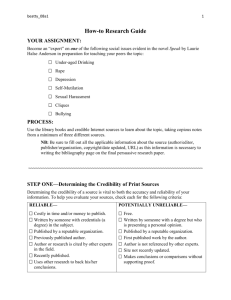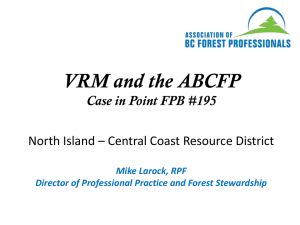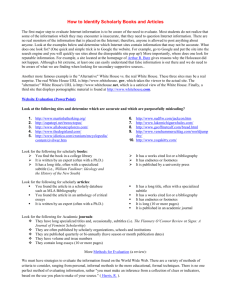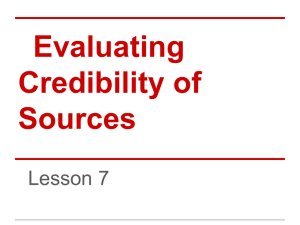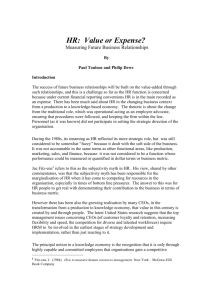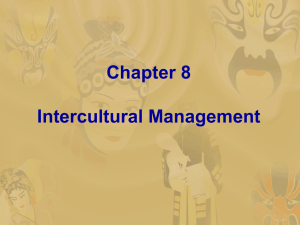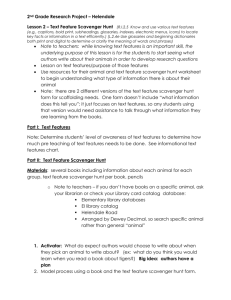Credible Sources Lesson - Kathy Glass Educational Consulting
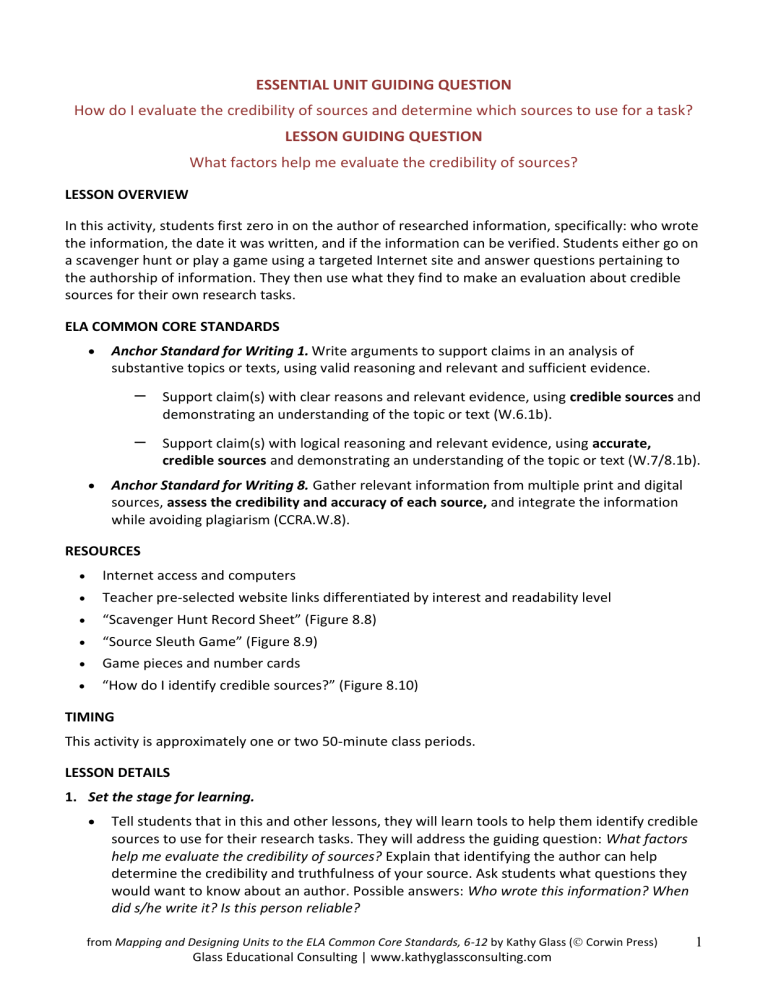
ESSENTIAL UNIT GUIDING QUESTION
How do I evaluate the credibility of sources and determine which sources to use for a task?
LESSON GUIDING QUESTION
What factors help me evaluate the credibility of sources?
LESSON OVERVIEW
In this activity, students first zero in on the author of researched information, specifically: who wrote the information, the date it was written, and if the information can be verified. Students either go on a scavenger hunt or play a game using a targeted Internet site and answer questions pertaining to the authorship of information. They then use what they find to make an evaluation about credible sources for their own research tasks.
ELA COMMON CORE STANDARDS
Anchor Standard for Writing 1.
Write arguments to support claims in an analysis of substantive topics or texts, using valid reasoning and relevant and sufficient evidence.
─
Support claim(s) with clear reasons and relevant evidence, using credible sources and demonstrating an understanding of the topic or text (W.6.1b).
─
Support claim(s) with logical reasoning and relevant evidence, using accurate,
credible sources and demonstrating an understanding of the topic or text (W.7/8.1b).
Anchor Standard for Writing 8. Gather relevant information from multiple print and digital sources, assess the credibility and accuracy of each source, and integrate the information while avoiding plagiarism (CCRA.W.8).
RESOURCES
Internet access and computers
Teacher pre-selected website links differentiated by interest and readability level
“Scavenger Hunt Record Sheet” (Figure 8.8)
“Source Sleuth Game” (Figure 8.9)
Game pieces and number cards
“How do I identify credible sources?” (Figure 8.10)
TIMING
This activity is approximately one or two 50-minute class periods.
LESSON DETAILS
1. Set the stage for learning.
Tell students that in this and other lessons, they will learn tools to help them identify credible sources to use for their research tasks. They will address the guiding question: What factors
help me evaluate the credibility of sources? Explain that identifying the author can help determine the credibility and truthfulness of your source. Ask students what questions they would want to know about an author. Possible answers: Who wrote this information? When
did s/he write it? Is this person reliable? from Mapping and Designing Units to the ELA Common Core Standards, 6-12 by Kathy Glass ( Corwin Press)
Glass Educational Consulting | www.kathyglassconsulting.com
1
Tell students they will engage in an activity in which they delve into the kinds of questions they just generated about the author of an information source. Explain that not all of the information they seek will be available for every source. This activity is intended to show them the kinds of information they might see to get a sense of credibility. Make these points to students or use them for your own edification when teaching:
─
Recognizing credibility is not cut and dry. With web sources it is hard to determine credibility, but considering the questions posed in this activity will help.
─
Information sources that are missing answers to some of the questions posed does not necessarily mean that they are entirely unreliable. Therefore, use the activity questions subjectively to determine credibility. These questions are not a checklist. Rather, they are designed to be an opportunity to practice locating, identifying, and processing this kind of information.
─
Other factors of credibility include when an article was written and if the source can be verified. For certain topics, how old the information is can impact its reliability and accuracy. Examples of information where date is important can include presidential elections, Olympic Games, latest scientific findings, or current events. Where the date might not be so important is when researching about a historic event like what is in King
Tut’s tomb or the Trail of Tears, or information about a person from the past like Helen
Keller, Albert Einstein, or Julius Cesar. The caveat is when these events or people become a current event because of a new finding. Ask students to volunteer their own examples of when date is important or not so important when researching sources.
2. Investigate the credibility of sources.
I offer two group activity options described below as a means for students to practice carefully critiquing a site’s authenticity. They then use what they learn to evaluate the credibility of their own sources for research projects they are conducting. You might choose to skip the group activities, though, and merely distribute Figure 7.8 “Scavenger Hunt Record Sheet” for students to complete for examining their own research.
For either activity option, do the following: (1) Invite students to select a topic of interest from a list you have prepared. (2) Arrange them into groups according to their selected topics and also their readability levels. (3) Issue a website address to each group. I suggest having students select a topic on one day and then spend time that evening forming the appropriate groups to be announced the following day.
─ Option 1: Conduct a scavenger hunt. Once students are situated into groups, distribute
Figure 7.8 “Scavenger Hunt Record Sheet” to each student. Instruct them to work together to discuss and complete it based on their assigned site. Although they are working in groups, each student should complete the handout.
─
Option 2: Play a game. Students play a board game using Figure 8.9 “Source Sleuth
Game” to investigate information about the author of material on a website. To start the game, students put a game piece on the “Start” box. This can be a collection of pieces you or students provide, such as beans, pennies, buttons, macaroni, metal rings, or paperclips.
In addition, provide duplicate number cards with a 1, 2, and 3 point value for students to place face down. Assign students a website and ask them to open the link next to their prepared game cards. Students determine who goes first. This person turns over a number card and moves to the spot on the board indicated by this number. Using the from Mapping and Designing Units to the ELA Common Core Standards, 6-12 by Kathy Glass ( Corwin Press)
Glass Educational Consulting | www.kathyglassconsulting.com
2
source information on the website, the student answers the question. Other group members must agree on a correct answer before it is the next student’s turn. Repeat so that students continue to move around the game board answering and discussing questions based on the website. The game is over with the first person (or all students) reach the “End” spot.
─
Differentiation. To prepare for either of the two group activity options, determine a list of topics that might interest your students such as sports, animals, art, or music. Find several sites that span readability levels and record these website links. Ask students which topics they are each interested in and arrange them into groups based not only on topics of interest but also based on readability levels.
Assign appropriate website links to each group. Please do not choose hoax sites as it is difficult to transfer these skills form fictional topics to information on topics students will actually encounter. Work with groups that need additional support.
3. Debrief with classmates.
Invite groups to share one or two key findings about what they found or didn’t find from their sites. Use the following as a springboard for discussion based on either the questions on the scavenger hunt sheet or the game board: Is it important to be able to answer every question?
Why or why not? What do we do when we find sources where there are a lot of unanswered questions? What do you think about the credibility of your site after investigating answers to
these questions?
To close this lesson, have students complete a sentence starter. You might say: “We have started to learn about what makes a credible source. Using what you learned in this lesson,
complete this sentence starter in your journals: When we research, it is important to….”
Have volunteers share their sentences and come to a class consensus based on responses.
Guide them to respond with something close to this: “When we research, it is important to find and use credible sources. To help determine credible sources, researchers need to know about
the author, when the article was written, and how this source can be verified.”
4. Recognize and apply credibility factors.
Make copies of Figure 8.10 “How do I identify credible sources?” for each student. Before distributing it, show and read the top paragraph only on a document camera or overhead.
Explain that this handout will be a resource for them as they consider credible sources to use for their tasks. Remind them that it is not a checklist, but rather a set of ideas to get them started. No website will meet all these criteria, and some websites that do may have other factors that make students suspect them. Then uncover the whole sheet and show them that they have already focused on the top four rows. Explain that in subsequent lessons, you will lead them in lessons to tackle the other aspects of credibility.
Option: You might have students complete Figure 8.8 “Scavenger Hunt Record Sheet” for their particular research tasks if they have not done so already,
ASSESSMENTS
Participation in group and class discussions
“Scavenger Hunt Record Sheet”
Participation in “Source Sleuth” game (if played) from Mapping and Designing Units to the ELA Common Core Standards, 6-12 by Kathy Glass ( Corwin Press)
Glass Educational Consulting | www.kathyglassconsulting.com
3
SCAVENGER HUNT RECORD SHEET
Search Topic: _________________________ Site Address: ________________________________
Group Members: ______________________________________________ Class Period: ________
Directions: Review a site and answer these questions and prompts. You may divide this task among group members.
Who wrote this information?
What is the author’s education, training, or
experience as it relates to this content?
Does s/he have a professional title or is s/he
recognized as an authority? Identify the title.
Is the author connected with an organization?
If so, can you determine if it is a respected
organization? Name the organization.
Can you contact the author or company?
How?
If the author is unnamed, can you take extra steps to find information about this author?
What steps did you take?
When was the article written?
Does the author include a date for the
information written? What is it?
Is it important that the information be current
or are you researching a topic from long ago?
Do the links on the site work, or are they
outdated?
Can the information be verified for accuracy?
What sources does the author of this
information use? Name one.
Are these sources listed in the article?
Does the author include a works cited or other links to provide additional resources or
original source information? Identify one.
Are there identified sources for any data or statistics in the content? Write one statistic
and its source.
Can you find other sources that share the same information, or is this the only source?
Name which other source you accessed.
FIGURE 8.8 Reprinted from Google Search Education/Lesson Plans (http://www.google.com/insidesearch/searcheducation/lessons.html). from Mapping and Designing Units to the ELA Common Core Standards, 6-12 by Kathy Glass ( Corwin Press)
Glass Educational Consulting | www.kathyglassconsulting.com
4
SOURCE SLEUTH GAME
Directions: Sit with a partner and access your assigned information page on the web. Take turns playing this game. When you land on a square, answer the prompt based on the source information on your site. Discuss each of your answers so there is agreement before taking the next turn.
What is the author’s education, training or experience?
Does the author have a professional title? What is it?
Is the author connected with an organization? Which one?
START
Can you contact the author or company?
How?
Is the author unnamed? How can you find the name?
Do you feel this source is credible? Why or why not?
Does the author include a date for the information? What is it?
Is it important that the date is current? Why or why not?
Can you find other sources that share the same information? Which sources?
END
Do the links on the site work?
What sources does the author of this information use?
Are the sources the author uses listed in the article? Where?
Does the author include a works cited or other links? Identify one.
Figure 8.9 Reprinted from Google Search Education - Lesson Plans (http://www.google.com/insidesearch/searcheducation/lessons.html).
Are there identified sources for any data or statistics in the content? Show one statistic and its source. from Mapping and Designing Units to the ELA Common Core Standards, 6-12 by Kathy Glass (
Corwin Press)
Glass Educational Consulting | www.kathyglassconsulting.com
5
How do I identify credible sources?
When collecting evidence for a research project, information report, argument paper, or similar task, it is important to use factual information. For an argument paper, it is true you want to sway your reader and will have a clear position and perspective. However, basing your evidence on facts will be more convincing to your readers. For a research project or report, you will want to include accurate and reliable facts and information.
Consider the following when you collect evidence so you can use credible sources.
Does the writing seem too good to be true?
Sometimes content seems so amazing that it makes a reader wonder if it’s true or not. Beware of this as it can indicate unreliability and inaccuracy. Ask these questions to help you determine if the writing might be largely untrue: Does this information seem unbelievable? Does it make sense to you or others? Does what you read conflict with something you already know to be true? Does the writing seem like hyperbole where something is grossly exaggerated? Is there a way to check this information out so you know whether it is true or not?
Who wrote this information?
Identifying the author can help you determine the credibility and truthfulness of your source. Consider these questions: What is the author’s education, training, or experience as it relates to this content? Does he or she have a professional title or is he or she recognized as an authority? Is the author connected with an organization? If so, can you determine if it is a respected organization? Can you contact the author or the
company? If the author is unnamed, can you take extra steps to find information about this author?
When was the article written?
For certain topics, how old the information is can impact the reliability and accuracy. Does the author include a date for the information written? Is it important that the information be current or are you researching a topic
from long ago? Do the links on the site work, or are they outdated?
Can the information be verified?
To check the accuracies of information, we might consider these questions: What sources does the author of this information use? Are these sources listed in the article? Does the author include a works cited or other links to provide additional resources or original source information? Are there identified sources for any data or statistics in the content? Can you find other sources that share the same information, or is this the only source?
How might the tone or style of the writing reflect its credibility?
The actual design of the website will not necessarily mean it is unreliable. What is most important is the actual writing. The way in which an article is written can reveal clues about its credibility. Consider the following:
Does the article have several grammar, spelling, punctuation, or capitalization errors? Is the writing emotional and include language that has a bitter, critical, or demanding tone? Is the writing so informal that it seems hard to trust? Does it seem unfair or extremely slanted to a point of view and biased? If it is biased, are there facts to back it up or other sites to verify what it states? Does it seem like it would anger or manipulate people?
Why does the author write this information?
Sometimes people write articles for reasons that contribute to unreliability, bias, and untruths. This doesn’t mean that a company writing an article about something it is passionate about will be unreliable. Or that a person who writes a persuasive piece is completely biased. Argument papers are by nature meant to persuade a reader, so take this into account while reading. As you read sources, use your judgment and the clues about credibility to make sure you access the information you need to satisfy your task.
Figure 8.10 Reprinted From Google Search Education/Lesson Plans (http://www.google.com/insidesearch/searcheducation/lessons.html). from Mapping and Designing Units to the ELA Common Core Standards, 6-12 by Kathy Glass (
Corwin Press)
Glass Educational Consulting | www.kathyglassconsulting.com
6


